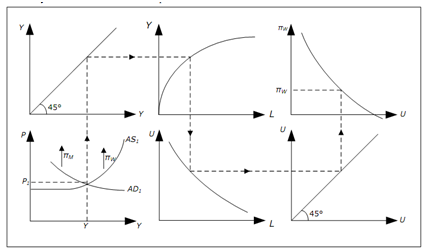Determination of all endogenous variables
We can explain how all the endogenous variables are determined in below figure:
Figure: The Keynesian model with the Phillips curve

1. Start at bottom left. In year 1, AD1 and AS1 apply, price level is P1 and GDP is Y.
2. Extend this level of GDP up to top left diagram and through 45-degree line to the production function at the top in middle.
3. In this figure we can determine how much L we need to produce Y. Extend this amount of labor down to lower middle graph and through 45-degree line to bottom right graph.
4. This figure demonstrates relationship between L and U. The higher the unemployment rate U, the lower the amount of labor L and curve slopes downwards. From L we can conclude U which we extend up to Phillips curve in the right top graph.
5. From the Phillips curve, we can figure out wage inflation ΠW.
6. Going back to the AS-AD figure, we now the rate at which AS curve slides up or down.
AD curve slides at a rate determined by ΠMthat is exogenous.
A significant case is when the growth in money supply is equal to wage inflation. In this case, Y is fixed and Π = Πw = ΠM. If, though, ΠM exceeds the wage inflation, AD curve will glide upwards at a faster rate than AS curve. Now Y will increase and if you follow the effect through all the 6 diagrams, you see that L will increase, U will decrease and ΠW will increase. Y will continue to increase as long as ΠW < ΠMthat means W will continue to increase until ΠW = ΠM.
In Keynesian model with the Phillips curve, p and ΠW will ultimately be equal to ΠM. As wages are presumed sticky in this model, it may take a long time for ΠW to become equal to ΠM.